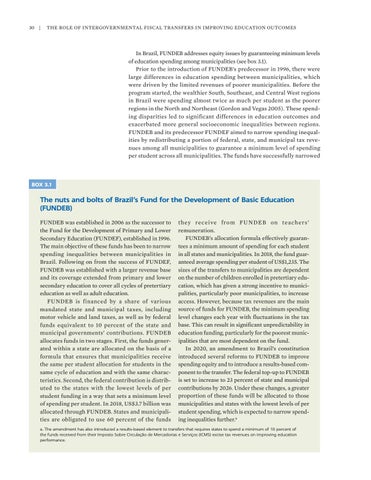30 | The Role of Intergovernmental Fiscal Transfers in Improving Education Outcomes
In Brazil, FUNDEB addresses equity issues by guaranteeing minimum levels of education spending among municipalities (see box 3.1). Prior to the introduction of FUNDEB’s predecessor in 1996, there were large differences in education spending between municipalities, which were driven by the limited revenues of poorer municipalities. Before the program started, the wealthier South, Southeast, and Central West regions in Brazil were spending almost twice as much per student as the poorer regions in the North and Northeast (Gordon and Vegas 2005). These spending disparities led to significant differences in education outcomes and exacerbated more general socioeconomic inequalities between regions. FUNDEB and its predecessor FUNDEF aimed to narrow spending inequalities by redistributing a portion of federal, state, and municipal tax revenues among all municipalities to guarantee a minimum level of spending per student across all municipalities. The funds have successfully narrowed
BOX 3.1
The nuts and bolts of Brazil’s Fund for the Development of Basic Education (FUNDEB) FUNDEB was established in 2006 as the successor to the Fund for the Development of Primary and Lower Secondary Education (FUNDEF), established in 1996. The main objective of these funds has been to narrow spending inequalities between municipalities in Brazil. Following on from the success of FUNDEF, FUNDEB was established with a larger revenue base and its coverage extended from primary and lower secondary education to cover all cycles of pretertiary education as well as adult education. FUNDEB is financed by a share of various m andated state and municipal taxes, including motor vehicle and land taxes, as well as by federal funds equivalent to 10 percent of the state and municipal governments’ contributions. FUNDEB allocates funds in two stages. First, the funds generated within a state are allocated on the basis of a formula that ensures that municipalities receive the same per student allocation for students in the same cycle of education and with the same characteristics. Second, the federal contribution is distributed to the states with the lowest levels of per student funding in a way that sets a minimum level of spending per student. In 2018, US$3.7 billion was allocated through FUNDEB. States and municipalities are obligated to use 60 percent of the funds
they receive from FUNDEB on teachers’ remuneration. FUNDEB’s allocation formula effectively guarantees a minimum amount of spending for each student in all states and municipalities. In 2018, the fund guaranteed average spending per student of US$1,235. The sizes of the transfers to municipalities are dependent on the number of children enrolled in pretertiary education, which has given a strong incentive to municipalities, particularly poor municipalities, to increase access. However, because tax revenues are the main source of funds for FUNDEB, the minimum spending level changes each year with fluctuations in the tax base. This can result in significant unpredictability in education funding, particularly for the poorest municipalities that are most dependent on the fund. In 2020, an amendment to Brazil’s constitution introduced several reforms to FUNDEB to improve spending equity and to introduce a results-based component to the transfer. The federal top-up to FUNDEB is set to increase to 23 percent of state and municipal contributions by 2026. Under these changes, a greater proportion of these funds will be allocated to those municipalities and states with the lowest levels of per student spending, which is expected to narrow spending inequalities further.a
a. The amendment has also introduced a results-based element to transfers that requires states to spend a minimum of 10 percent of the funds received from their Imposto Sobre Circulação de Mercadorias e Serviços (ICMS) excise tax revenues on improving education performance.






